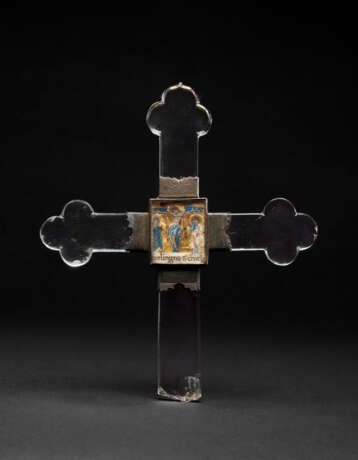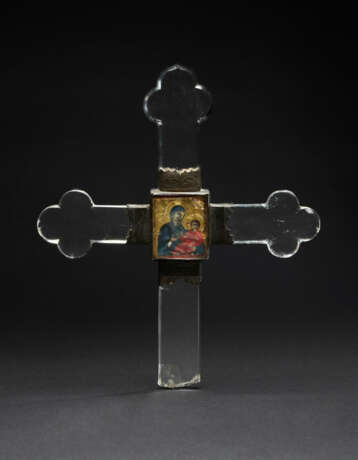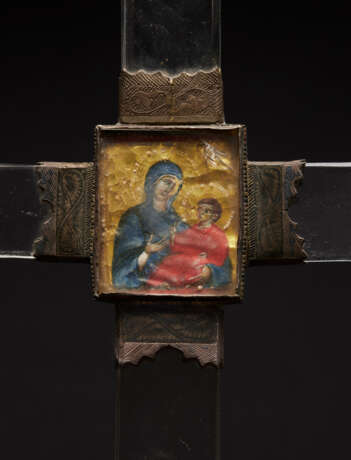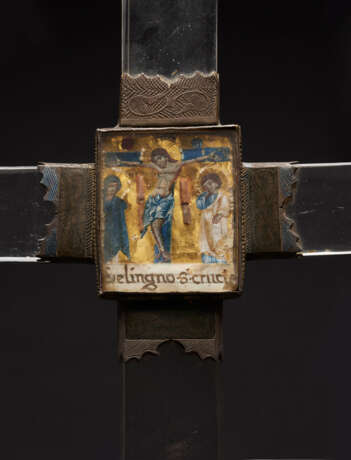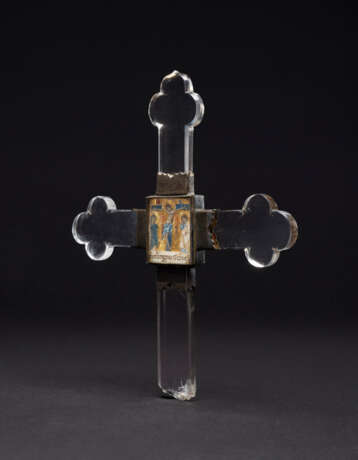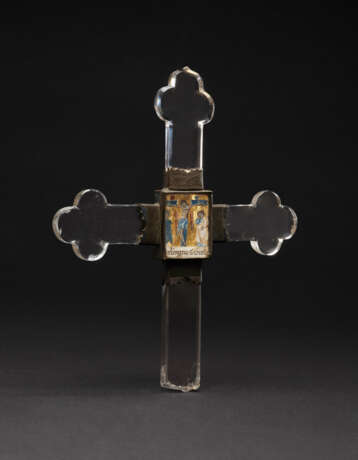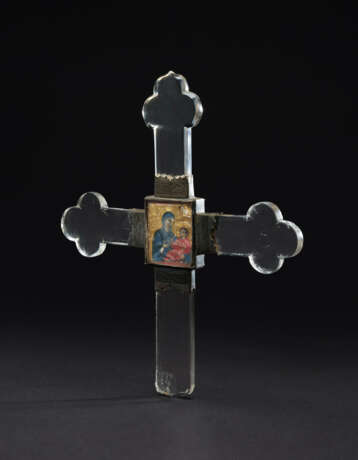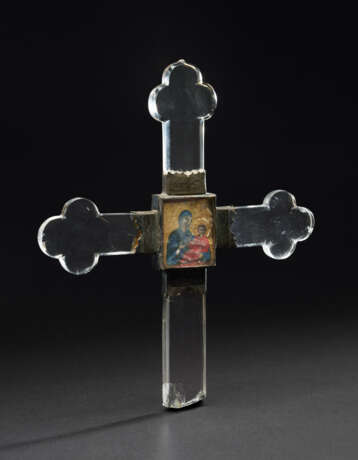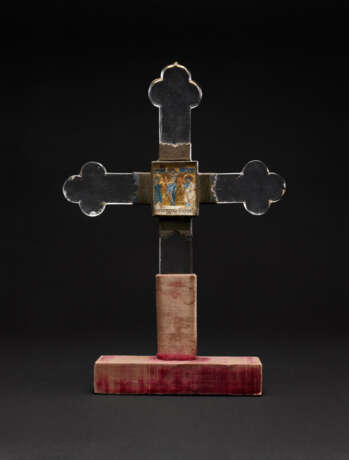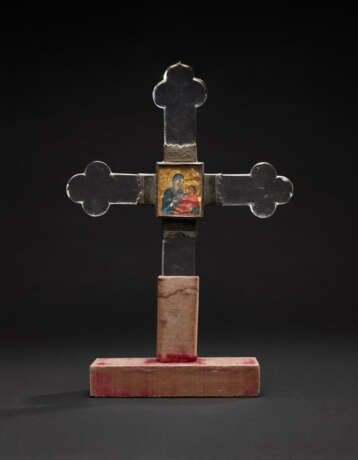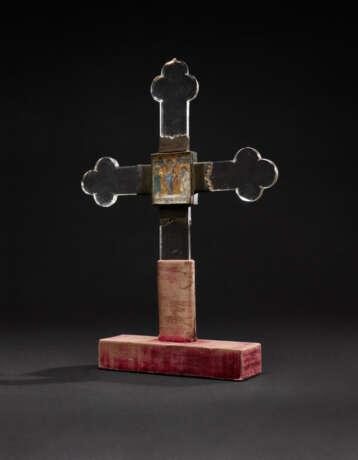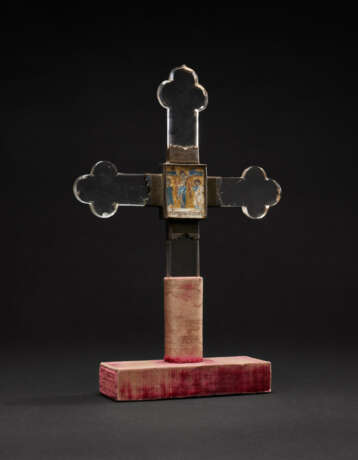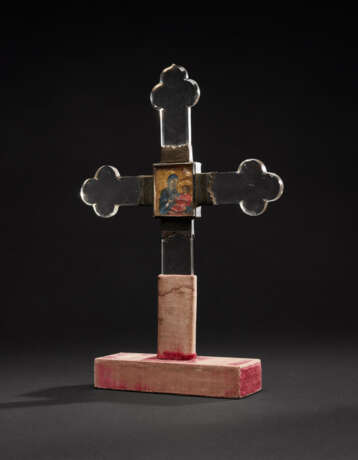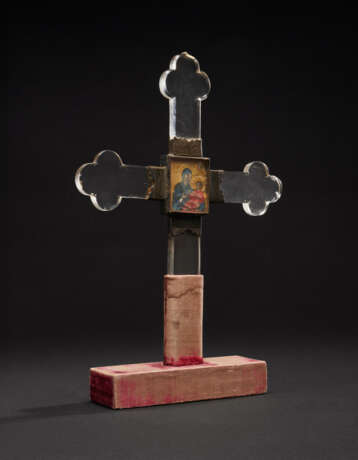ID 1230041
Lot 10 | ITALIE DU NORD, PROBABLEMENT VENISE, FIN DU XIIIe OU DÉBUT DU XIVe SIÈCLE
Estimate value
€ 10 000 – 15 000
Croix reliquaire
cristal de roche et monture en argent et argent niellé probablement du début du XIVe siècle, les deux miniatures à fond d'or sur vélin à décor de perles fines de la fin du XIIIe ou du début du XIVe siècle, l'une représentant la Crucifixion avec des reliques de la Vraie Croix et l'inscription rapportée sur vélin "delingno.St.crucis", et sur l'autre la Vierge à l'Enfant ; on y joint un socle postérieur en velours rouge ; le bras supérieur postérieur et le bras inférieur fragmentaire
H. 22,5 cm (9 in.) ; L. 19,5 cm (7 ¾ in.) ; H. totale avec le socle 28 cm (11 in.)
Literature
Bibliographie comparative :
H. R. Hahnloser et S. Brugger-Koch, Corpus der Hartsteinschliffe des 12.-15. Jahrhunderts, Berlin, 1985, pp. 27-28, pp. 47-48, pl. 99, fig. 112, pl. 112, fig. 127a, pl. 118, fig. 133a.
Silvia Spiandore, Preziose trasparenze. La miniatura veneziana sotto cristallo di rocca (secoli XIII-XIV), Thèse de doctorat, Università degli studi di Padova, 2014
M. Beer, Magic Rock Crystal, cat. expo., Museum Schnütgen, Cologne, 2022, pp. 148-151.
Further Details
A SILVER MOUNTED ROCK CRYSTAL RELIQUARY CROSS WITH TWO MINIATURES ON VELLUM, NORTHERN ITALIAN, PROBABLY VENETIAN, LATE 13TH OR EARLY 14TH CENTURY
In 1284, in Venice, the most important medieval centre for hard-stone craftsmanship, the Brotherhood of Crystal Cutters appeared, regulating an organisation that had come into being in the middle of the century. The speciality of these workshops was precious rock crystal reliquaries with metal mounts in which miniatures were integrated. The technique of combining crystal and goldwork, already in use in Northern Europe and perfected in Venice, was honed to imitate Byzantine cloisonné enamels. Rather than producing enameled plates, the sculptors - who worked in collaboration with illuminators - used "ornamental" miniatures, executed as stand alone images, protected by rock crystal plates, giving the same brilliance to the surface and shine to the colours, and whose extreme transparency was perfectly suited to reliquary objects. This wealth of production took place in a favourable economic and creative context. Venice's large merchant fleet enabled precious objects such as crystal miniatures to be exported throughout Europe, making them accessible to a wide range of Venetian and foreign customers keen to own luxury goods.
Our reliquary cross is one of a series of crosses with three-lobed rock crystal arms decorated with miniatures that were produced in Northern Italy from 1300 to the 16th century. The date is given by the mounts, which consist of a central panel in a slender frame flanked by partly niello rings with scalloped edges, typical of early 14th-century production and similar to that of a cross in the Museu Nacional de Machado de Castro. The typology of the miniatures confirms this analysis. In fact, the bright colours, gold-leaf background and tiny fine pearls adorning the nimbus are typical of Venetian illuminations intended for this purpose during this period, as can be seen with an early 14th-century cross in the Museu Nacional de Arte Antiga in Lisbon (inv. no. 191).
| Applied technique: | Metalwork |
|---|---|
| Medium: | Semi-precious stones, Silver, Rock crystal |
| Place of origin: | Italy, Europe |
| Category: | Cross |
| Auction house category: | All other types of objects, Icons |
| Applied technique: | Metalwork |
|---|---|
| Medium: | Semi-precious stones, Silver, Rock crystal |
| Place of origin: | Italy, Europe |
| Category: | Cross |
| Auction house category: | All other types of objects, Icons |
| Address of auction |
CHRISTIE'S 9 Avenue Matignon 75008 Paris France | ||||||||||||||
|---|---|---|---|---|---|---|---|---|---|---|---|---|---|---|---|
| Preview |
| ||||||||||||||
| Phone | +33 (0)1 40 76 85 85 | ||||||||||||||
| Fax | +33 (0)1 40 76 85 86 | ||||||||||||||
| Conditions of purchase | Conditions of purchase | ||||||||||||||
| Shipping |
Postal service Courier service pickup by yourself | ||||||||||||||
| Payment methods |
Wire Transfer | ||||||||||||||
| Business hours | Business hours
|
